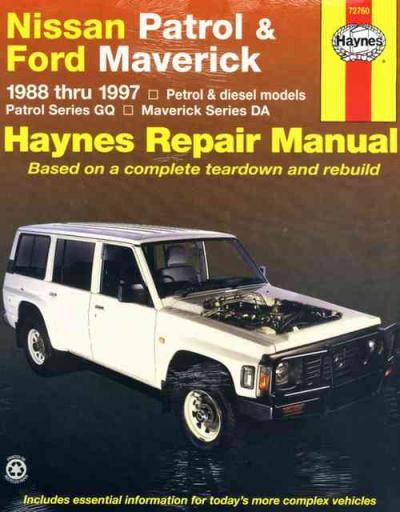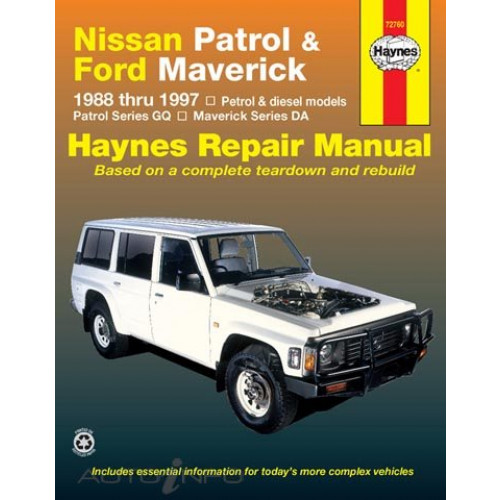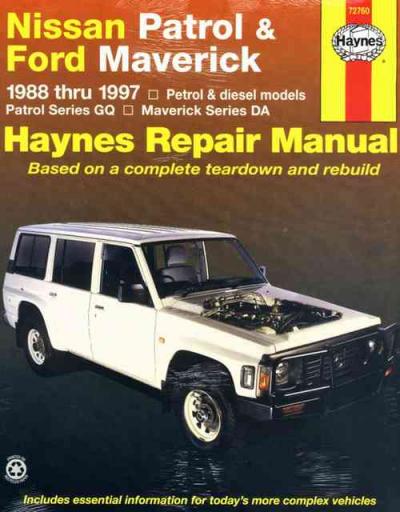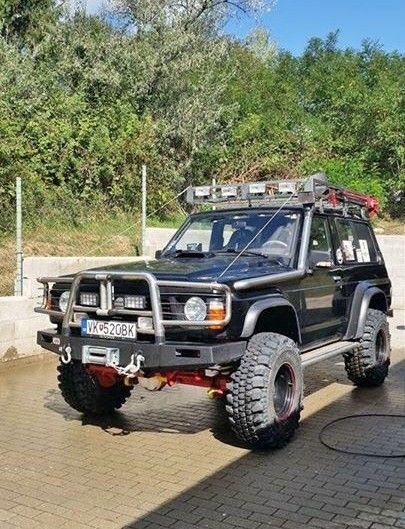Nissan Patrol GQ Ford Maverick DA 1988 1997 Haynes Service Repair Manual
Nissan Patrol GQ 4WD Ford Maverick DA Haynes Petrol and Diesel Service and Repair Manual 1988-1997Other Nissan Car Repair Manuals click hereOther Nissan Patrol Repair Manuals click hereNEW paperback 304 pagesNissan Patrol GQ & Ford Maverick DA 1988 - 1997 Haynes Owners Service & Repair Manual covers: Nissan Patrol GQ and Ford Maverick DA models from 1988 to 1997, fitted with petrol and diesel engines. Does NOT cover UK Ford Maverick or Nissan Terrano. Engines Covered: Inside this manual you will find: Routine Maintenance, tune-up procedures, engine repair, cooling and heating, air-conditioning, fuel and exhaust, emissions control, ignition, brakes, suspension and steering, electrical systems and wiring diagrams.
|
Most designs had a back minimal slide differential plus some variations have a vacuum or electric solenoid run handbook rear differential lock. A rear sway club launch device was also available on some designs. Some Y60s also have a PTO-driven front-mounted winch, with an in-cab control lever found to the right for the gearstick.
The Patrol was labeled Safari in Japan, in which it featured a 24V electrical program, instead of the standard 12V.
The TD42 and TB42 were readily available with both a five-speed handbook and a four-speed automated gearbox. The RD28T and the RB30 were just available with a 5-speed guide.
Trim levels in Australian Continent included:
DX with handbook mirrors, no main locking, plastic interior, optional AC, manual locking hubs.
RX (from 1995) with electric mirrors, main locking, carpeting internal, AC, manual securing hubs.
ST with electric windows, electric mirrors, central locking, carpeting indoor, AC, automated locking hubs.
Ti (from late 1989) with electric house windows, electric mirrors, main locking, velour and carpet inside, rear AC, seven presenter speakers, alloy three-spoke tires, automated locking hubs. The Ti design had a high roofing design with sunroof until 1991. Leather and woodgrain trim ended up being made standard in 1992 aided by the Series 2.
An array of dealership fitted accessories were readily available including sunroofs, roofing racks, tow bars, driving lights, cargo barriers, and side steps. The TD42 had been available with an optional Safari turbocharger at some Australian dealers.
Trim level in Europe diverse considerably nation by country. These include designations like SLX, LX and many more in France. Finnish Patrols emerged traditional with 2 batteries.
The RB system is a 2.0--3.0 L straight-6 four-stroke petrol/gasoline system from Nissan, created from 1985-2004.
Both SOHC and DOHC versions has an aluminium mind. The SOHC variations has 2 valves per cylinder as well as the DOHC variations posses 4 valves per cylinder; each cam lobe moves just one device. All RB machines has belt-driven cams and a cast iron block. Most turbo versions posses an intercooled turbo (the exclusions becoming the solitary cam RB20ET & RB30ET machines), and a lot of posses a recirculating factory blow off device (the exceptions becoming when fitted to Laurels and Cefiros) to lessen compressor surge if the throttle quickly closes. The Nissan RB motor is derived from the six-cylinder Nissan L20A system that has the same bore and stroke since the RB20. All RB machines were produced in Yokohama, Japan where the brand new VR38DETT has become made. Some RB motors are reconstructed by Nissan's NISMO unit during the Omori Factory in Tokyo too. All Z-Tune Skylines were entirely rebuilt during the Omori Factory.
Four different types of 3.0 L RB30 were created from 1985 - 1991:
RB30S GQ Patrol - carburetted single-cam 100 kW at 4,800 rpm, 224 nm at 3000 rpm
RB30E VL Commodore - fuel-injected single-cam (114 kW (153 hp) at 5,200 rpm, 247 N*m (25.2 kgf*m) at 3,600 rpm)
RB30E R31 Skyline - fuel-injected single-cam (117 kW (157 hp) at 5,200 rpm, 252 N*m (25.2 kgf*m) at 3,600 rpm)
RB30ET VL Commodore - fuel-injected single-cam turbo (150 kW (201 hp) at 5,600 rpm, 296 N*m at 3,200 rpm)
This motor is produced for usage within the Skylines, Patrols and rights bought by Holden since the Holden 202 (3.3 L) running the Holden Commodore could not satisfy tightening emissions requirement, with brand new cars expected to run using unleaded petrol by 1986 a quick replacement was recommended. Nissan Motor Co. offered the RB30E to Holden when it comes to VL Commodore. Because radiator is fitted lower in relation to the system in the VL, there's an increased probability of environment locks creating inside (alloy) cylinder head, causing this to overheat and warp. This was more unlikely when you look at the R31 Skyline because the radiator try installed higher. The system proved to be most trustworthy besides this matter. The RB30S ended up being within some center Eastern R31 Skylines plus some Nissan Patrols. The RB30E was present in R31 Skylines and VL Commodores in Australia as well as in South African R31 Skylines (with 126 kW at 5,000 rpm and 260 Nm at 3,500 rpm)
The turbocharged RB30ET (producing 150 kW) was discover just when you look at the VL Commodore (available in all brands) and contains a diminished compression RB30E bottom end, stronger oils pump, T3 Garrett turbocharger, 250 cc injectors and another type of intake manifold. The engine is still well-known these days in Australian and New Zealand motorsport and drag rushing in VL Commodores, R31 Skylines and swaps various other vehicles
Nissan Special automobiles unit Australia created two restricted types of R31 Skylines, the GTS1 and GTS2. These contained slightly more powerful RB30E engines, containing longer opening duration webcams and best flowing exhausts.
GTS1 RB30E - injected single-cam (130 kW (174 hp) at 5,500 rpm, 255 Nm (26.0 kgf*m) at 3,500 rpm) - unique cam profile, special exhaust
GTS2 RB30E - injected single-cam (140 kW (188 hp) at 5,600 rpm, 270 N*m (27.5 kgf*m) at 4,400 rpm) - special cam profile, special exhaust, piggy right back computer, valve porting
There were two big news in Australian Continent, one out of 1992 (GQ Series 2), the other in 1995 (lesser facelift). The most notable alterations in 1992 being the development of fuel-injection regarding the TB42 motor with gasoline injection, EGR valve and oil colder from the RD28T, brand-new chairs, latest trim, sound deadening and part intrusion taverns. Other 1992 show 2 refinements included the modified transmission, suspension system, presenting bigger brakes, bigger tires therefore the standardization of restricted slip diffs and automobile freewheeling hubs. This improvement additionally provided the motorist newer seating, trim and side intrusion taverns.
In 1991 a corner indicators, tail lighting and brake lights were relocated towards the bumper through the human anatomy to satisfy Australian Design procedures, however they stayed similar inside European versions. In 1992 another collection of indicators had been added to the front quarter panel.
In August 1993 the TD42 ended up being lightened so that you can lessen fuel intake and also make it rev much harder. And also this had the side effect of weakening the motor. The first motor is identified by its silver rocker address, whereas the lightened system featured a black rocker cover. In addition the RD28T have some additional modifications, in this instance the machine pump have moved from behind the alternator to your top of the motor. In addition driver airbags began to come in some European designs.
1995 spotted a small renovation, with a redesigned front side grille, plus the RX model being introduced in Australia.
Known weaknesses feature oscillations from the forward end (mostly set under warranty), cracking hinges on a corner home (due to the extra tyre's fat) and rusty back window structures. The RD28T motor normally proven to undergo head gasket issues whenever driven with huge base. Additionally European five-speed gearboxes suffer with bearing problems in 5th gear at large mileages. having said that the reliability of TD42 is virtually celebrated. Patrols will also be recognized for their strong axles and close restricted slide differential (whenever therefore complete).
From 1988 to 1994, Ford Australia rebadged the Y60 Patrol, because the Ford Maverick. This was a direct result the switch car program created because of the federal government of Australia. The car was mechanically identical but highlighted different paint colours and trim levels.
All wagons had a 95-liter primary gas container utilizing the energy having a 90-liter tank while the choice of a 95-liter subtank.
It is not usually a vehicle maker introduces an all-new design alongside the older. But that is just what Nissan Australian Continent has done with its biggest off-roader, starting the much-anticipated Y62 V8 petrol Patrol in February while continuing to offer the elderly and far less expensive Y61 turbo-diesel variation.
With the brand new, upmarket Patrol best offered with a petrol motor, and diesel-powered SUVs a lot sought-after in Australia, Nissan have little choice but to hold the ageing Patrol oiler in the line-up; just as much to appease the Nissan faithful as minimise losing business to their primary rival, the V8 turbo-diesel Toyota LandCruiser.
The upshot is those pursuing a full size, off road truck with a Nissan badge will have two distinctly different choices. There is the out-dated, truck-like, but tough-as-nails Y61 Patrol, priced properly from ,890. Or even the much fancier, high-performance, high-tech Y62 Patrol, which begins at ,200 and, fully-loaded, spending a lot more than two times the price of the cheapest diesel Patrol.
And in addition, equipment values are globes aside. Although around ,000 cheaper than the mid-spec Y62 Patrol Ti tested, the auto-equipped Y61 Patrol ST lacks fundamental services within most K hatchbacks, like steering wheel settings and a decent trip computers.
The 2013 model-year Y62 Patrol, by comparison, seems really the twenty-first century chariot. In place of the older Patrol's utilitarian, grey cabin plastic materials are a plush, woodgrain-finished, techno-laden interior from the build manual of Nissan's premiums Infiniti brand name. Our just disappointment had been the possible lack of a touchscreen for LED colour display.
Although the Y62 Patrol is slighter bigger externally and internally than its slab-sided predecessor, both provide ample wriggle place and good comfort level for seven or more people. Though itis no surprise modern version does a more satisfactory job of pampering their occupants.
But perhaps the biggest comparison is the method they do on-road. Powered by an under-stressed 3.0-litre, four-cylinder turbo-diesel making 118kW at 3600rpm and 354Nm at 2000rpm, running all the way through an obsolete four-speed car transmission, the 2447kg Y61 truck try slow from the level and lethargic on the road.
Additionally it is loud at greater revs and handles like a tradie's ute around corners, with loads of understeer through the reasonably supple suspension system.
In comparison, the muscular 5.6-litre petrol V8 in Y62 Patrol renders a mockery of the 2706kg bulk. With 298kW at 5800rpm and 560Nm at 4000rpm on faucet, it blasts from zero to 100km/h in a silky smooth and recreations sedan-like 6.6 moments -- dual, or triple that, the old Patrol!
The direct-injected petrol V8 revs willingly right into the 6250rpm redline, assisted by a seven-speed automated keen to kick down a gear or three whenever requested. The disadvantage are a hefty thirst, with official fuel consumption of 14.5L/100km versus the diesel Patrol's 11.8L/100km.
The petrol Patrol is a lot quieter on highway, rides better, and despite its higher mass may be hustled more with confidence through corners, with good suggestions through controls.
Both of these ladder frame-based beasts become suitably furnished for serious off-road services. The latest Patrol boasts better ground clearance although arguably the tough older design could have the slight side in actually harsh material; its slow-revving diesel motor considerably better for crawling over challenging boulders and the like.
However for 44 beginners, the user-friendly electronic devices and off road switchability in petrol Patrol render 'on-the-fly' bush-bashing most accessible compared to the Y61 featuring its old-school 'low number' shifter.
Which begs issue: that will be a much better proposition for towing a reasonably heavy caravan, trailer motorboat or horse float?
In some recoverable format, the Y62 Patrol shapes up exceptional with a towball optimum of 350kg and braked towing capacity of 3500kg, set alongside the Y61's 250kg and 2500kg (increased to 3200kg on manual versions).
With up to 500Nm available from 1600rpm, compared to the diesel Patrol's paltry 354Nm from 2000rpm, the Y62 also has a distinct benefit in all-important, low-down torque (or pulling power).
The distinctions had been highlighted on the way, with both Patrols tested over a 100km bitumen path comprising freeway and hilly sections, while pulling Jayco caravans evaluating around 2500kg.
In relation to off-the-mark acceleration, the V8 Patrol powered away with scant respect for just what had been at the rear of. In comparison, the diesel Patrol actually struggled to get up to date, and more revs didn't make much distinction.
Struggling with simply four gears, the Y61 furthermore revved higher regarding highway beneath the additional burden, sitting around 2500rpm at 90km/h. It also slowed dramatically on extended inclines, stubbornly staying with third equipment despite quickly dropping rate.
Having less handbook equipment selection has also been restricting (besides a 'fixed' second gear), particularly when wanting to utilize engine braking down steeper decreases to protect brake system.
In comparison, the petrol Patrol have no dilemmas maintaining and even increasing rate while rising longer inclines, though it usually needed seriously to downshift and emit some good revs to do so. Gears could also be manually picked to create close use of engine stopping downhill.
It had been about range baseball when it found car security under tow, with no higher pitching or swaying; their significant fat without doubt assisting keeping affairs in order.
However, both dipped significantly in back suspension, indicating aftermarket burden levellers might necessary to amount them down.
Fuel economic climate ended up being another close competition, however in a good way. Driven solamente, the Y61 taped 13L/100km, blowing off to 25L/100km towing. The Y62 Patrol gone from a fuel-guzzling 17L/100km solamente to an eye-watering 28L/100km towing.
So which will be a far better tow tug? If towing efficiency are crucial, the latest Patrol gains, without doubt. It's up indeed there because of the ideal, and then we'd feel confident of it easily managing the utmost 3500kg.
Although the manual Y61 Patrol tows around 3200kg, we would feel hesitant going a great deal beyond two tonnes with either the guide or car offered our experience.
However, if gasoline economy is very important, because it's with several grey nomads, we would pick neither, in addition taking into consideration the V8 Patrol calls for 95 RON advanced unleaded. Additionally it is well worth noting the possibly limiting touring range of both motors, despite 125 litre (Y61) and 140 litre (Y62) fuel tanks.
The downsides of both Patrols is reflected in latest VFACTS numbers, with Patrol (older and new) purchases down 20 % this present year while the larger Nissan consistently lose share of the market to the LandCruiser.
Until Nissan presents a turbo-diesel Y62 Patrol with close or more grunt versus petrol V8, we would choose rather for a Toyota LandCruiser or Land Rover advancement 4 as a heavy-duty tow tug. Both compete highly using Y62 Patrol on towing capabilities and properties your money can buy, without having the gasoline pump aches.
old 91 Model Nissan GQ Patrol.. I sold the mighty GQ, and upgraded to a GU patrol in 2006 This site is no longer updated.. WHATS NEW! Sometime 2006 Sold the ...
Nissan Patrol Parts - NissanPatrolParts/Home
Nissan Patrol Parts Red Hot Specials APRIL SPECIALS: Road Safe Drag Links ... This is a kit for overhauling GQ Nissan Patrol with Single Piston Front Brakes
Find great deals on eBay for nissan gq patrol nissan patrol gq ute. Shop with confidence.
New & Used Nissan Patrol GQ cars for sale in Australia ...
Search for new & used Nissan Patrol GQ cars for sale in Australia. Read Nissan Patrol GQ car reviews and compare Nissan Patrol prices and features at carsales.com.au
The GQ was the first Nissan Patrol with coil springs, released in Australia in 1988. The standard coils sag and limit axle movement, but a GQ Patrol with after-market ...
Find great deals on eBay for nissan gq nissan patrol. Shop with confidence.
Nissan Patrol - Wikipedia, the free encyclopedia
The Nissan Patrol (Japanese: 日産・パトロール Nissan Patorōru) is a series of large four-wheel drive vehicles manufactured by Nissan in Japan since 1951.
Find news about Nissan in GQ.com. GQ. Style; Grooming; Women; Entertainment; Culture; Video; Subscribe. Newsletter Search. You need to enter a correct e-mail address.
Nissan Patrol GQ 4WD Ford Maverick DA Haynes Petrol and Diesel Service and Repair Manual 1988-1997 1989 1990 1991 1992 1993 1994 1995 1996

 0 Items (Empty)
0 Items (Empty)





 >
>